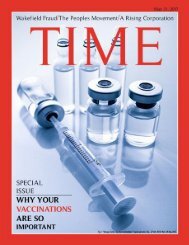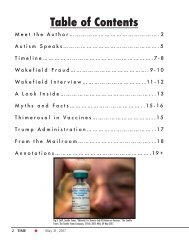JEP fin
Create successful ePaper yourself
Turn your PDF publications into a flip-book with our unique Google optimized e-Paper software.
incidence as well as age specific incidence for those children. Following analysis was conducted<br />
on 114 boys who had a diagnosis of autism between the ages of 2-5. They found that the estimated<br />
yearly incidence of those under the age of 12 increased sevenfold from 0.3 per 10,000 people<br />
in 1988 to 2.1 per 10,000 people in 1999. The peak ages where autism was first diagnosed was<br />
3 and 4 years. The median of the dataset was 4.6 years. It was known that autism rates in the<br />
United Kingdom increased, and this study shows that increase was nearly “fourfold among boys<br />
aged 2 to 5 years born in 1988-93.” The data supported the fact that there is no causal association<br />
between MMR vaccination and the risk of autism.<br />
In comparison with A Population-Based Study of Measles, Mumps, and Rubella Vaccination and<br />
Autism, I found that both were a population study, and the latter was of children born in 1991-<br />
1999. While the MMR vaccine was introduced to the United Kingdom in 1988, the vaccine was<br />
first introduced in 1987. They both consulted research databases with information on autism,<br />
ran a structured study, and came to the same conclusion that there is no causal relation between<br />
MMR vaccination and autism. The second was on a much larger scale, with a total of 537,303<br />
children in the cohort and 2,129,864 in follow-up This source is objective because it is a study<br />
conducted from a relatively large sample size and is from a reputable site.<br />
This source is useful as it is a time trend analysis that supports my claim. It will be used to support<br />
the claim as well as provide information in the form of graphs for my <strong>JEP</strong> remix of a magazine.<br />
It has not changed my view on my topic, instead it enhanced and supported what I know.<br />
The fact that they conducted more research on a specific age group of children that were determined<br />
to be at higher risk, with the same conclusion that I have, will be used to refute those who<br />
say that the vaccine is more likely to cause autism in the first 5 years.<br />
Maglione, Margaret A., et al. “Safety of Vaccines Used for Routine Immunization of US Children: A Systematic<br />
Review.” AAP News and Journals Gateway, June 2014.<br />
In this source titled “Safety of Vaccines Used for Routine Immunization of US Children: A<br />
Systematic Review” conducted by Margaret Maglione and nine other individuals, addressed<br />
concerns about vaccine safety that have lead to the the decline of vaccinations in children and the<br />
increase of diseases. The systematic review that they conducted consulted sources that “included<br />
PubMed, Advisory Committee on Immunization Practices statements, package inserts, existing<br />
reviews, manufacturer information packets, and the 2011 Institute of Medicine consensus report<br />
42 TIME May 31, 2017





